Raising the Discus fish - Care, Breeding, Forum & Everything for happy Discus
Quick links – Answers
- Care
- Breeding
- Tank setup
- Food & diet
- Best pH for discus
- Best GH for this species
- Ideal water temperature
- Tank mates
- Fungus in discus fish
- Best filtration
- Gill fluke medication
- Do I have to have real plants for my discus?
- Can gouramis live with discus?
- How many years does a discus take to grow adult?
Brief Description
This page is an ultimate guide on raising Discus fish with pictures, forum and answers - Just scroll down and you'll find answers on most of your questions. Also visit other pages devoted to Discus fish: Discus fish - revision of this page (but with smaller forum), Discus FAQ, Red discus profile, Blue discus profile, Discus profile. We'd love to hear how you keep your Discus and thus you're welcome to post your experiences at the bottom of this page!
By Stokes; 19/05/2008: this article has been revised, the new version is here; see copyright information here
Introduction and general information
The Discus is a large cichlid from the Amazon River, its tributaries and flood planes, in South America. Discus and its variants were first described in 1840 by Dr. Heckel as Symphysodon discus, this name is now in use for the Heckel discus variant. The three "original" colour variants received their own name, the Green Discus Symphysodon aequifasciata aequifasciata, the Brown discus Symphysodon aequifasciata axelrodi, and the Blue variant Symphysodon aequifasciata haraldi.
More and more people are choosing to keep this species over other fish and care for it. By becoming more popular more money is going into the industry which assists the funding for research and the development of products and different strains of these fish.
The discus is a social fish and lives in large groups in their native waters, and has a very advanced social behaviour; they are one of the few real schooling cichlids.Bear this in mind when starting care for discus; always purchase a group of animals. They need the social interaction to develop their character to its best potential.
Currently, it is becoming increasingly difficult to find the original colour variants in pet shops, only the Heckel is sometimes imported. Most of the fish you encounter today are captive bred colour variants. At this time the list of described colour variants is nearly endless. Some of the colour variants have lost their stripes and therefore their natural ability to communicate in the school. But as always these new variants are finding their way to the aquarium hobbyist quickly for exceptionally high prices and this will stimulate the breeders to try to find a new one. One of the advantages of the captive bred discus is that they are now much easier, not easy, to maintain as the imported ones. They are much more tolerant concerning water conditions.
It is getting increasingly easier to keep discus with new technology to improve water quality and their health which could be the cause of the rise in demand. New dealers and breeders are growing rapidly and even small aquatic shops are stocking a range of Discus.
They are beautiful but yet still remain a challenge to keep and breed with the later been very rewarding and will even pay for the hobby. Most people that keep Discus will at some stage want to breed them as it is a great experience.
This guide should give you the knowledge to be able to keep your Discus at a good standard and help you breed them without any big problems. Even if you’re a beginner this guide should be the only one you need.
Discus fish pictures - part 2


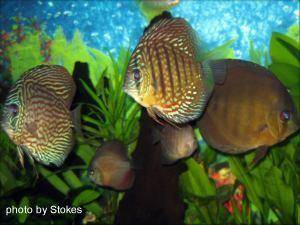
The Tank
The very first question you should ask yourself is, “What size aquarium do I need?” This depends on your budget and the room you have in your home.
Tank size
If you are having, or planning a display tank it is recommended you host them in a tank no smaller than 120 x 40 x 50 cm (47 x 16 x 20 inch).
Due to the shape of a discus body it is better to keep them in deep tanks, in addition the more water the tank holds the more stable the water conditions tend to be which is important for their health. For a breeding tank a 48 x 30 x 30 cm (19 x 12 x 12 inch) tank may be used which is adequate for this purpose.
Position
Discus are very shy fish and tend to hide when they are not confident so keep the tank away from noisy and busy areas especially near door ways and halls. Keep their tanks away from direct sunlight and radiators as sunlight will cause algal bloom and excess heat. The only other factor to take into consideration is the height of the tank, the higher up the better as Discus are phased by movement above and this may cause them undue stress.
Substrate
This depends on whether you are breeding your fish or just displaying them. If you have a display tank we do recommend you to use finer gravel. If you are breeding them it is best you have a bare bottom tank as it is easier to clean.
Plants
If a keeper is going to have plants it is possible either to use plastic plants or live plants. Plastic plants do not produce oxygen and do not grow which is against preferences of many aquarists, however it is up to every keeper to decide whether to clean plastic ones on a regular basis, or whether to enjoy and grow live ones. Lately, silk plants have become all the rage and they look much more realistic than plastic, which would add to the aesthetics of the aquarium.
In a display tank you can now get a good plant selection by mail order, these plants tend to be cheaper and better than those you find in aquatic shops. In a breeding tank you may either leave them out or just have one or two potted plants in the tank.
Décor
You may wish to decorate the tank with rocks and driftwood. Driftwood is suitable for discus as their native waters often have roots and driftwood where they find shelter. Rocks should be checked for any metal ore and contaminants. Also try and keep rocks of a similar colour and texture, preferably from the same source, though a different piece adds nice contrast.
Sunken ships, no-fishing signs and plastic mermaids do not belong in a discus tank as caring for fish means something else than senseless decorating. Try and keep décor to a minimum, it will serve the tank both functionally and aesthetically.
Filtration
It is a well known fact that Discus require excellent water quality, and a good filter is at the heart of this. Now there is not one type of filter that suits a Discus tank best as different filters do different jobs and it just depends on what you need it for.
Types of filtration
There are basically three types of filtration these are:
- Mechanical
- Biological
- Chemical.
Mechanical
This is the first stage of any filtration; the water is drawn or pumped through layers of material that removes any free floating debris from the water. This is important, as sediment will block the next stage of filtration rendering it useless. If the flow rate of your filter drops off then clean or replace the mechanical media immediately.
Biological
The heart of the filter, basically bacteria will live in this area of the filter, they convert the fishes waste, (ammonia) to nitrite and finally nitrate, thus creating a safe environment for your Discus. Porous materials such as ceramics feature in the form of noodles and chips. These have millions of pores in which beneficial bacteria crucial to the removal of ammonia and nitrite, reside and establish colonies. It is important to never clean the media in tap water. You should rinse the media in tank water from water changes, when it is required.
Chemical
The final stage of filtration is very much controlled by you, for various reasons you may wish to add carbon or peat to the filter, these filter media either absorb impurities, or alter the chemical balance of the water. This is usually topped off with a fine wool pad to polish the water as it returns to the aquarium.
Filtration Media
Filter media is the stuff that goes inside your filter, mainly an external filter. It cleans the water and removes the harmful toxins from the water.
Mechanical Media
Any media will have mechanical capabilities, but the idea of dedicated mechanical media is that it protects the biological media from becoming clogged with debris. It usually tend to be sponges of some sort or the other. Whatever you use it is best to use many layers to filter out the dirt. If maintained regularly then the mechanical media can be washed out and re used several times, if left too long you will have to throw it away and replace with new media.
Biological Media
This is the heart of the filter and so long as you use sufficient pre-filtration it is unnecessary to ever clean it. Biological filter bacteria live here, they colonize any nook, cranny or rough surface, so it goes without saying that the more surface area your media has the more bacteria will gather on it, thus improving the filtration process. Bacteria will cling to any surface from smooth gravel to the modern ceramic rings products which I use that offer massive surface areas. Ceramic rings products are available in any aquatic outlet and are highly recommended for any flow through filter. If at any stage the biological media does become clogged with muck, it is vitally important that it is washed in old tank water. Do not use tap water, you will kill all the friendly bacteria, which in turn leads to total filter failure, ammonia or nitrite poisoning and ultimately dead fish.
Chemical Media
It may at various times be necessary to add some activated carbon to your filter to remove medications or dyes from the water. Also you can use peat to soften the water, or perhaps Nitrate and Ammonia removing resins. Any chemical media should be last in line of the filtration process, and it is important to adhere to the instructions supplied as to the life span of these media, because some of them will let the toxins back into the water once exhausted.
Pictures - part 3
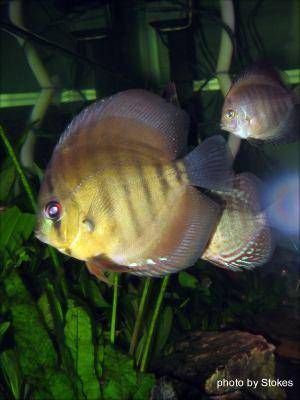
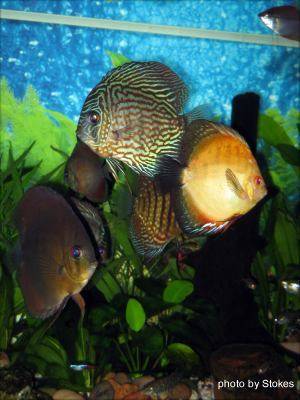
Types of filters to use
Display tanks
If you have a diplay tank then it is strongly recommend to use an external canister filter as these will keep the water very clean and they do have one of the largest surface areas for biological filtration which will secure the water quality at excellent levels. An external canister filter will sit outside the tank and you should be able to get one to fit any tank.
Alternatively aquarists could use a trickle filter but they tend to be quite expensive. Another option is to use an internal filter but make sure it doesn’t cause too much current as Discus do not like strong flow of water!
Breeding tanks
In a breeding tank it is important to keep things simple. For this reason fishkeepers prefer to have bare bottom tanks with just a sponge filter. Many breeders recommend this method as it has been tested and worked for years. A corner filter may also be used. This will give you a bit more control over the water as you can add some peat etc. I would not recommend using an internal power filter as the fry, once free swimming, will get sucked in and will die. A sponge filter can be picked up cheap and is run by an air pump. Once every week, squeeze the sponge in the tank water you’ve removed from doing a water change as this won’t kill the bacteria in it.
The Water
The quality of water in a Discus Aquarium is very important. Some even say it is the most important factor in keeping your fish healthy and happy. This species will thrive in the right water so it is essential to get it right.
pH
It is not recommended to change the pH without a reason as this is best left for someone with a background in chemistry. Discus that are tank bred usually do well in hard alkaline water too. Unless you acquire wild discus or the breeder or supplier’s water parameters are different from your local tap water, you may need to alter the pH. Even then small pH changes at a time, remember the pH scale is logarithmic, so a drop from 7 to 6 is actually reducing the pH by a factor of 10 and from 7 to 5 by 100.
Here below is what the recommended pH is:
- Display – 6.5 – 7.5
- Breeding – 5.5 – 6.5
- Growing On – 6.8 – 7.5
If it is needed to lower the pH you could use peat which is a great natural alternative which gradually decreases the pH.
Hardness
There are two types of hardness, general (GH) and carbonate (KH).
Pictures - part 4
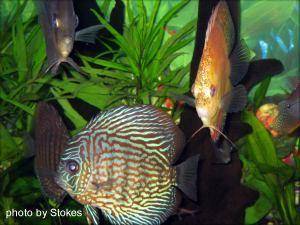
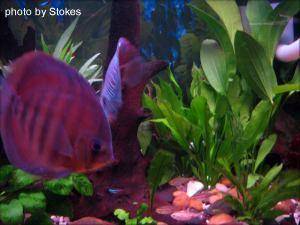
These days more aquarium bred Discus are available and based on your locality and that of the breeder, so in order to avoid an osmotic shock it is wise to ask regarding general water hardness at the shop before fish are finally purchased. Then you can adjust the general hardness by mineralising or de-mineralising (Reverse osmosis units are used to achieve this) prior to introducing any specimens to your tanks.
One should try to avoid keeping them in very soft water, as purists would have you believe, as a lack of the minerals in the water contribute to HLLE (Head and Lateral Line Erosion) and poor growth in young discus growing on. To change your hardness you can again buy water treatments or to lower it you can use a reverse osmosis unit which will be covered soon. If the water is not too hard to begin with, you may consider filtering through peat filled in a nylon stocking placed in your filter.
Temperature
Discus generally require higher temperatures than other tropical fish and a keeper should think of this when selecting plants and tank mates for them. To change temperature simply, adjust the heater’s dial in your aquarium. Having two heaters in some tanks just encase one does not function may be a good thing, though do not use a cheap heater as a malfunction could cost you dearly. Keep an eye on the temperature at least twice daily as part of your routine. A conventional thermometer is not recommended as I’ve found they may vary slightly, and are not precise. A digital thermometer is recommended for precision and accuracy. One should always ensure that the incoming water during a water change is approximately equal to the water in the tank, a slight variance within 1.5 degrees, as the discus can suffer temperature shock and this would bring on undue stress which could eventually lead to an outbreak of disease.
Below are the recommended temperatures for Discus tanks:
- Display – 27.5 to 29°C (81.5 - 84.2°F)
- Breeding – 30 to 33°C (86.0 - 91.4°F)
- Growing On – 29 to 31°C (84.2 - 87.8°F)
Water Preparation
If after testing your water you are happy that it fits the water chemistry required to keep Discus you can do a couple of things. You can simply add a treatment like Tetra Aqua Safe which will take out chlorine, chloride and some metals. You can also use a heavy metal filter which will take out all heavy metals and make the water perfect. Or you can mix the two like I do to save on time and money.
If your water doesn’t meet the criteria and it is poor to start with, you will need to filter it through a Reverse Osmosis unit. These can cost a packet, but are worth it if you need them. This filtration process will remove a very high percentage of heavy metals, chlorine, pesticides, silica, nitrates and most of the Total Dissolved Solids, it will also lower the pH of freshwater. The product water, as with distilled water, on its own is unsuitable for Discus. The reason for this is that there are no salts in this water which would buffer any drops or peaks in pH. What you do is add to it a supplement containing electrolytes and salts, or some de-chlorinated tap water. Better still mix RO water with a percentage of water prepared with a HMA filter. The exact percentages to mix really are determined by your geographical location, but as a rule 75% RO to 25% tap is usually about right.
If you wish to breed Discus and to care for the fry you need a supply of very soft water, in order to keep the water very soft, i.e. less than 50 ppm (2.8°N dGH, 1.00 mEq); you use less tap water in the mix. But a word of warning, soft water is very unstable and must be changed daily to avoid pH crash.
Water changes
It is very important to change the water in your tank on a regular basis, in a display tank it is recommended around once or twice a week and with the later for breeding tanks and anything up to once a day for growing on tanks. I like to change in between 20-40% of the water in the tank but in the fish farms in the Far East they change 100% of the water once a day in the growing on tanks with great results. The reason for this is that discus like other fish, secrete a hormone into the water that inhibits their growth. This allows the fish to stay appropriately sized for the volume of water it is contained in. It is for this reason that wild specimens and those subjected to abundant water changes grow to such large sizes. When changing the water clean the bottom of the tank and suck up all of the debris on the tank floor but try and disturb the fish as least as possible. Once they feel more secure, you can clean aggressively, but do not cause them stress by being noisy about it, just remember that sounds are amplified in water as it is a much better conductor of sound and shock.
Discus fish pictures - part 5
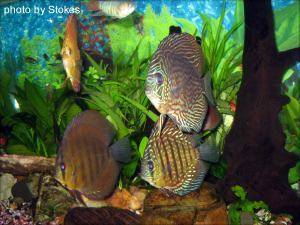
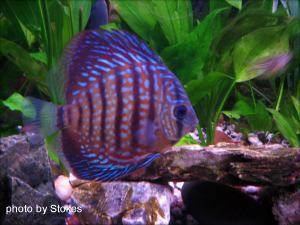
Selecting Discus for your aquarium
Buying these specimens shouldn’t really be any different to buying any other fish but it seems to cause most people worry and sleepless nights. I suppose it’s the money involved as not many other fish have the price tags Discus fish carry.
Before buying Discus, you should have done your homework and know about the fish, water chemistry and how to care for it. This may seem like common sense but some people don’t even know what water these fish prefer. Most keepers have this knowledge and the experience with other fish as they tend to keep other types of tropical fish before progressing on to the Discus. It is possible to keep Discus without any experience but it really isn’t recommended. I know of many hobbyists who started out with discus simply because they were mystified by them. Needless to say, some have had bad experiences, their entire stocks wiped out within a week.
When it comes to choosing stock there are three sources of stock, these are firstly importers and dealers that only deal with Discus, they tend to know a lot about the fish and have a good selection of different strains. Then there are pet shops which will normally only have a little selection of these fish and some times aren’t very good quality.
Lastly there are home breeders which are hobbyist who breed Discus, you can normally pick them up very cheap from such breeders but specimens tend to be very small fish. I would recommend you get your stock from an importer but look around and make your own decision.
What to look out for?
Some people will tell you to look for perfectly round bodies with small bright eyes and even though this is true there is simple more to it than that.
First you have to decide what colours you want, don’t worry too much about the names of these as they vary from source to source. Wherever you buy your fish from spends time watching them, and never buy on impulse. Only select fish that are alert, bold and come to the front of the tank. Avoid specimens that hang at the back and hide. Also avoid those that breathe heavily or out of one gill. Check for twisted mouths short gill covers, poorly shaped tails, odd or big eyes and any other genetic defects that might be down to poor breeding.
Talk to the dealer and ask him questions, ask if you can see the fish feed, most will let you. Healthy Discus will respond quickly to food. If the dealer declines, walk away. If he wants to sell the fish he will do this for you. Ask the dealer how long he’s had the fish, if less than 2 weeks be careful as they haven’t been quarantined long enough. Did he breed the fish or did he import them, if the later where from? Does he know if they have been subjected to any medications or de-wormed? These are all common questions which he should know the answer to and it will provide you with a good background as to the fish’s history and the dealer’s competence.
Take a look at the bottom of the tank, healthy Discus pass faeces regularly and their waste should be black. If you see signs of white or clear feces it is reasonable to consider that some of the fish have an internal problem such as intestinal worms, and so should best be left alone. Always ask what sort of water conditions the fish are in and if possible write it down. If they aren’t the same as yours go home and get them right. If you want the fish put a deposit down so the dealer will keep the fish for you and this also give you the opportunity to keep an eye on them for another week just to make sure they are healthy.
Try to get fish that are medium sized, adolescent so to speak. These are easier to adapt to new water conditions than larger fish, and don’t require frequent feeds as with young discus growing on.
Strains of Discus Aquarium Fish
There are plenty of strains of Discus fish available on the market now but all originate from the same species Symphysodon aequifasciatus. In the 80’s the Germans were the first to develop the blue varieties and other colours and varieties, but now east Asia develops some fascinating strains like Snow Whites, White Dragons, Pandas, which I am a particular fan of, as well as the Snakeskin, Thunder Flashes, Checkerboards etc.
New strains are been developed all the time and there is now getting a vast variety. However I would recommend the beginner stick’s to the classic strains like Red Turquoise and Blue turquoise, as these fish tend to be hardier and a little bit less fussy.
If you are buying young fish ask to see the parents or adult fish of that strain to make sure you know what you are getting. Most breeders or importers will be able to let you do this as they tend to stock the same strains of young and adults.
If you want a solid blue colour I recommend you go with the Blue Diamond or Cobalt Blue, and if you want a solid red then go with a Red Melon or Marlboro Red. If you want striped or patterned fish then go with snakeskin or pigeon bloods. There are also Tefe Greens which are recommended for advanced hobbyists, as well as Heckels and wild specimens, which should really be attempted by those individuals who have their hobby down to a science. Though keeping discus should not a scientific pursuit. Don’t forget to enjoy your hobby!
Discus fish pictures - part 6
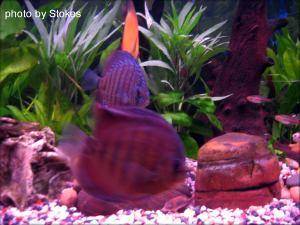

Tank Mates
So what should you keep with your Discus fish? Different keepers have totally different opinions on this subject but here is my opinion.
In a breeding tank you should only keep Discus and I strongly recommend you keep nothing else in there with them. Some people like to keep plecs and other sucker-mouth catfish, but I’ve had problems with them latching on and sucking to the Discus’ mucus covering. Algae eaters are also notorious for this.
However if you have a display tank then you want to make it look nice and have more than just these fish, I recommend you have a large shoal of small tetras like neon’s, cardinals and rummy noses. You can keep any peaceful, slow moving fish with discus, so long as they don’t dominate or out compete discus for food and space.
I believe that the Discus aquarium should be geared toward keeping discus and other species generally do not require the dedication and water that discus need.
Some people have kept this species together with angel fish, but other keepers would disagree with doing this for good reason. Angels can pass on disease to Discus fishes and angels can grow large and bully Discus so take this into consideration when you’re planning your tank.
Rams are also a favorite to keep with Discus fish. I’ve had success with dwarf gouramis as well as pearls, though the blue and golden gouramis are bullies and should be avoided. When you get young Discus make sure you get a shoal as like other fish they need the security of a shoal around them.
I personally keep discus in a community tank, and I have had success with many different species, these have adapted to the warmer water and do not offer any direct competition to the discus.
The Diet
Discus should be fed a varied, vitamin and protein rich diet. This is why it is important to feed them different foods and not just stick to one.
Flake
Any top brand fish flake will provide your fish with a complete diet. Discus prefer their food mid water to bottom so soak and squeeze the flake food first.
Brine shrimp
Discus love frozen brine shrimp, defrost and rinse it before feeding it. The carotene will enhance the colouration, and also serves to keep them in good overall condition.
Bloodworm
Definitely the staple of fish foods, very much a favourite but use only frozen irradiated worms as there is less chance of it having parasites in it. I feed mine bloodworm once daily.
Granular and Freeze Dried
Loads to choose from, all good for Discus. Stick to brand names for quality control. Tetra Bits are quite the favourite. Low quality food can cause bloating as the food absorbs water and expands, which could lead to constipation.
Live food - The health risks with live food far out weigh the benefits and with the menu above why take the risk. Stick to live brine shrimp and bloodworms from a good source.
As a rule, rather feed less, if you’re not sure. Discus are grazers and pick at their food slowly, so allow them five to ten minutes to eat well.
Information about Diseases and Medications
One thing I have learnt by keeping Discus is that they don’t usually just die for "no reason". In most cases there is some sign that something is wrong. When I ignored these signs, I lost precious fish. Some of the diseases and parasites I have encountered are described below.
Hole in the Head Syndrome
This is a disease often associated with Discus, but it also affects Geophagus species, Uaru amphiacanthoides and Astronotus ocellatus. If treated correctly it need not be a problem. If left untreated, it can cause permanent scarring and even death. The most important treatment is heat treatment. Over a couple of days raise the temperature from 30°C to 36°C (86 - 96.8°F). Additional aeration will be required to ensure adequate oxygen supply. This temperature must be maintained for 8 to 10 days for full recovery, however, the temperature must be dropped if the fish goes into stress. In addition to heat, the fish can be given Flagyl (Metronidazole) orally once every three days for the duration of the heat treatment. See next paragraph for the method.
Internal parasites
Internal parasites in the gut can be assumed, if the fish becomes emaciated or produces white, jelly-like faeces. I have no idea of what species of parasites are infecting our fish, but in most cases heat treatment (as for Hole-In-The-Head Syndrome) and Flagyl given orally cures the fish. To treat the fish, assuming the fish is still eating, soak some live blood worms or black mosquito larvae in a solution of 10 ml of liquid Flagyl to 200 ml of water for about one hour. Then feed the worms or wrigglers to the fish. This treatment can be repeated every 2 to 3 days for 10 days. If the fish is not eating, then the job is a little more difficult. I have had success by removing the fish from the water and placing it on a wet towel and injecting (using a syringe without needle) the medication down its throat. I use a 2 ml syringe and a mixture of 1 part liquid Flagyl, 2 parts of Liquifry (to try and get the fish’s strength up) and 3 parts water. Before returning the fish to the tank wait for the fish to swallow. It is normal for excess medication to be expelled from the fishes gills and mouth. This treatment can be done twice a day, until the fish shows signs of recovery. The treatment of non-eating fish is not always successful.
External parasites
External parasites come in many types and I am unsure of exact species. However, I have found by symptoms, that there are differences and different medications are required. Basically I have two main medications for use for external parasites.
* Jungle Labs Parasite clear which I use for fish that are scratching themselves on objects in the tank. I believe this to be skin fluke and use this drug for anything I feel requires mild treatment. Dosage is one tablet for every 40 litres (10.57 US gallons, 8.80 Imperial gallons) of tank water, repeating two weeks thereafter.
Gill fluke
Gill fluke is a common disease in Discus and is worth mentioning separately to other external parasites. In adult specimens, it is usually associated with heavy breathing, however, in fry it causes much greater problems. When young fish get to around 10 cent piece size, gill fluke may become a problem. The parents carry gill flukes in small amounts all the time and if the parents are left with the babies too long, after free-swimming, then the parents can pass them on to the babies. The classic symptoms are heavy breathing, and erratic swimming as though the fish has been bitten on the gill by something inside. This can be accompanied by a spasm and sudden paralysis resulting in the fish sinking motionless to the bottom. This condition seems to be brought on by overcrowding and high feeding rates associated with raising the fry, and can be avoided sometimes by spreading the fry out as they grow.
Bacterial infections
Bacterial infections can strike Discus the same as any other fish and I have found that two medications are good.
- The best is Chloromycetin and comes in powder form. The dosage is one teaspoon to 100 litres (26.42 US gallons, 22.00 Imperial gallons) of water. It is always fast acting and some improvement should be noticed in 8 hours if it is going to work for that condition. A second dose after two days may be needed, but there is no need to remove the previous dose as it dissipates out after 12 hours. It is important to store Chloromycetin absolutely dry and away from light.
- The other medication is Oxolinic Acid. A stock solution of half a gram of the powder in 500 ml (0.13 US gallon, 0.11 Imperial gallons) of de-ionised water can be made up and stored. The dosage is 1 ml of the stock solution to 10 litres of tank water. This treatment is only effective on some types of infections.
White Spot and Velvet Disease
These two diseases are rare in Discus due to the high water temperature (30°C ~ 86.00°F) they are kept at. But if you do happen to get these parasites then heat treatment will cure it without drugs. White spot is treated with 34°C (93.20°F) for 10 days, whereas Velvet Disease is treated for 2 days. Heat treatment can cure many problems, because most parasites can’t withstand high temperatures. Another parasite, which is also treated with heat, is Costia: 33°C - 34°C (91.40°F - 93.20°F) for 4 days.
Where to obtain these medications
- Flagyl in suspension (liquid Flagyl) is a prescription drug from the chemist. A prescription can be obtained from a veterinarian, if required.
- Para-Ex is made by Wardleys and is available from aquarium shops.
- Chloromycetin, can be obtained in capsule form from some chemists of veterinarians and some aquarium shops.
- Oxolinic acid can be obtained through a chemist from chemical supply houses.
Precautions
When heat treatment is used, use a separate low wattage externally adjustable heater and keep a careful eye on the temperature as often as possible. Make adjustments only if someone is home for a few hours after the adjustment, to minimise the risk of "cooking" your fish. When administering medications, calculate the tank capacity accurately to avoid overdosing. A good method is to take the internal dimensions in centimetres and multiply the length by width by height to the water line divided by 1000.
Copyright
This article uses some content from former Aquarticles. However, this article is based upon personal experiences of Rahim Irfaan. All pictures available on this page can be used on aqua-fish.net only since they are in our own ownership. You are not allowed to copy, redistribute or use any written part or images within this article without permission of aqua-fish.net. If you have any questions point them to the form which can be found at the top of this page.
Original author: Peter Gallagher.
First published in the Cichlid Circular, New South Wales Cichlid Society, Australia. November 1990
Other interesting reading about Discus fish
This page has been rewritten several times in order to give readers the perfect insight on raising Discus fish, however you're also welcome to read the comments below; Experiences and real examples, problems of fishkeepers are often better than any article! Apart from information that can be found within Aqua-Fish.Net, feel free to visit the following websites, they're worth it; Green Discus @ Animal-World.Com, Heckel Discus @ Animal-World.Com, Cichlids - Discus, Waroo @ Fish.Mongabay.Com, Discus Fish Picture Photo Gallery @ RockyMountainDiscus.Com, Discus Fish - Symphysodon aequifasciatus @ FishLore.Com, Discus Fish @ AquaticCommunity.Com. If any of the links doesn't work, let us know, please.







